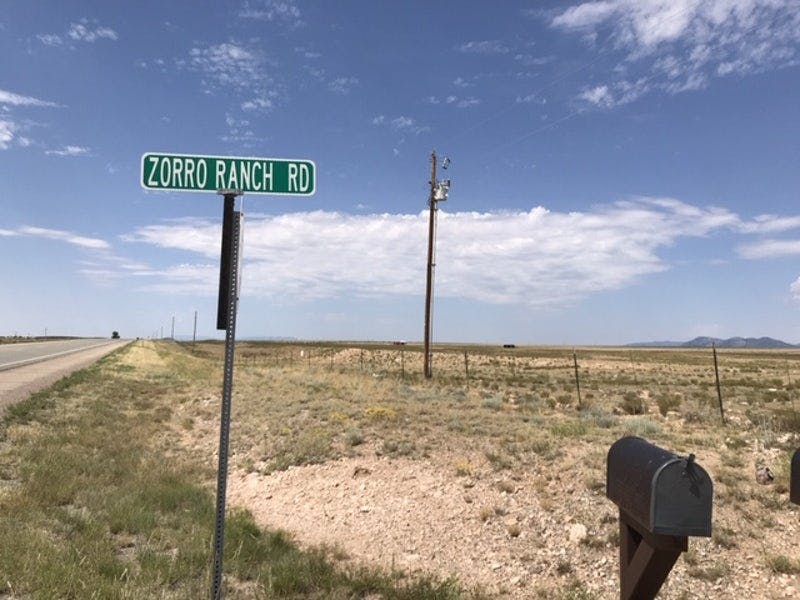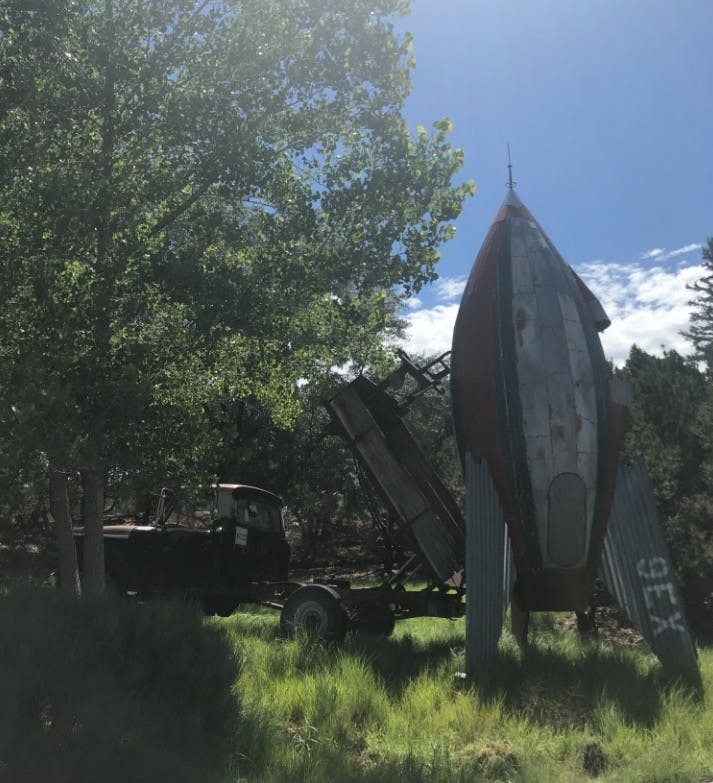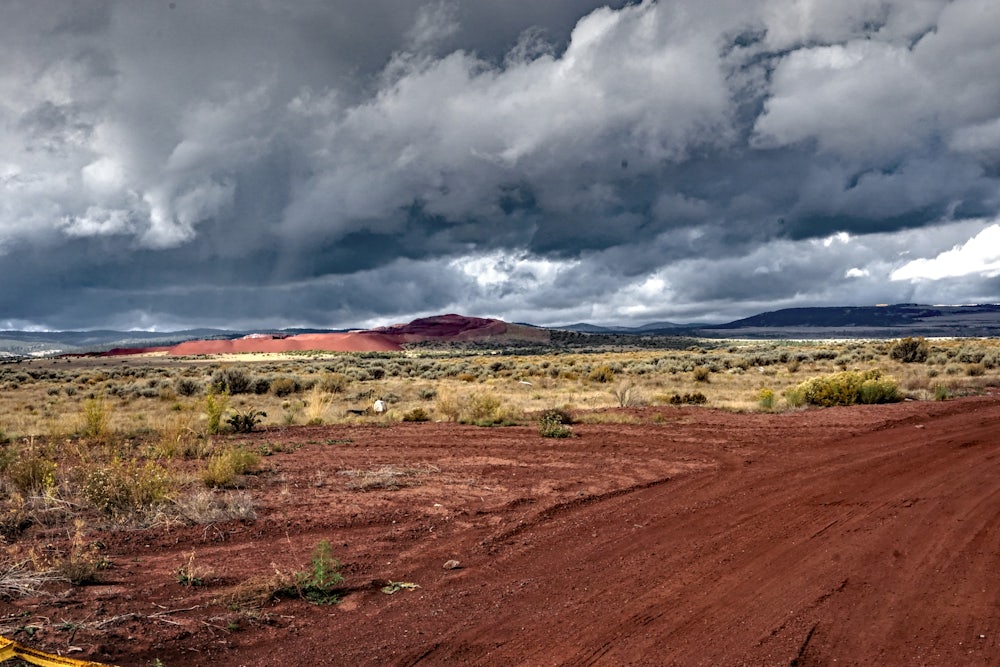If there’s a secret, New Mexico will try to keep it. The Land of Enchantment has gotten a lot of practice over the years, well before the now-late Jeffrey Epstein purchased the Zorro Ranch south of Santa Fe. The world’s first nuclear weapon, code name “Gadget,” was detonated in New Mexico on July 16, 1945.* Tourists can now visit the Trinity Site on the U.S. Army’s White Sands Missile Range to view the epicenter of a highly secret government conspiracy involving top physicists called the Manhattan Project. Trinity is a 111-mile straight line from Zorro Ranch. Consider what lies within this way: Find a map. Make Epstein’s New Mexico operation the center. Put the Trinity site at the edge of its radius. What else is secret and radioactive and inside that circle? Did New Mexico’s other secrets throw off enough chaff to keep Epstein off the radar?
Last month, I went to New Mexico to see what secrets I could find within the circle. Santa Fe, 23 miles away from Zorro as the crow flies, is the oldest colonial capital city in North America, one with a twisted history. The historic center of this small city in the foothills of the Sangre De Cristo Mountains is the Plaza, an open-air park with a Haagen-Dazs at one corner. This was once a drugstore, Zook’s Pharmacy, that doubled as a base for Russian espionage; in between filling prescriptions and ringing up customers, deep cover Stalinist spies here plotted the death of Leon Trotsky and later coordinated efforts to steal the secrets of the atomic bomb from Los Alamos (distance from Zorro Ranch: 50 miles).
There are dozens of other strange things in that circle. There’s the Armand Hammer United World College of the American West, a selective international boarding school in Montezuma founded by Armand Hammer and Prince Charles, originally a resort hotel built on a hot springs sacred to the Jicarilla Apache, the previous inhabitants of the Sangre De Cristos. Bill Richardson—who in recently unsealed court records was named by accuser Virginia Roberts Giuffre as a participant in Epstein’s illegal sexual abuse ring—claimed to be a lecturer at the United World College in 2001–2002, between his stints as Bill Clinton’s secretary of energy and New Mexico’s governor. Richardson only showed up once that the students were aware of, to publicly hobnob with Queen Noor of Jordan and Greece’s Prince Pavlos in advance of his gubernatorial run. (I was a student at AHUWC at the time; I recall that Richardson accurately called me a smart-ass.)

There are also the sites where the Catholic Church hid pedophile priests in local parishes, until a tsunami of lawsuits from victims forced New Mexico’s largest diocese to file for bankruptcy last June. One of those places is in Jemez Springs, an isolated resort town in the middle of a melange of federal ranges, Pueblo nations, and national forests. (Distance from Zorro Ranch: 50 miles.) Here, the Catholic Church still operates one of two treatment centers in the United States for pedophile priests. They are treated by fellow members of the cloth who belong to an order called the Servants of the Paraclete—the paraclete, of course, being the Holy Ghost. One wonders about the mental health care available for the victims, or whether they will ever really rely on the paraclete again.
We travel inside the circle, from one abusive church to another. A little over 80 miles northwest of Zorro Ranch is Trementina Base, a bunker and vault complex owned by the Church of Spiritual Technology—an elite order within Scientology—with hardened rooms storing L. Ron Hubbard’s writings. Hubbard’s thoughts on Thetans will survive anything, as they’re reportedly inscribed on etched steel plates in titanium containers filled with inert argon gas. The location is hardly secret, since the CST’s logo, two interlocking circles with diamonds, can be seen in aerial photos, carved into the high desert scrub, ostensibly to help guide Hubbard’s spirit back to its new body—whenever that happens. “Once Hubbard adopts a new body, he’s expected to make his way to one of the CST bases,” a Trementina Base insider told the Village Voice in 2012. “That’s where he’s supposed to be raised and be taken care of.”
If you’re rich, powerful, and committed to doing something strange and opaque, New Mexico beckons—as it did for Epstein a quarter-century ago.
On February 22, 1993, as Whitney Houston’s “I Will Always Love You” topped the domestic charts, the New Mexico State Land Office granted an agricultural land lease near the unincorporated community of Stanley to the Zorro Trust. The trust was a shell company for Jeffrey Epstein, whose address of record at that time was 457 Madison Avenue (which today also houses the headquarters of the Trunk Club personal-shopping service). On that same day, the Zorro Trust completed a purchase of lands owned by members of the King family, a powerful New Mexico agricultural and political dynasty. Zorro’s deal included rights to the Kings’ leases on public lands, a total of 1,159 acres rented for $872.22 a year. The largest private landowners in New Mexico are either outside billionaires or family dynasties.
“Very often we will just be a wealthy landowner’s way of consolidating their holdings,” Stephanie Garcia Richard, the New Mexico land commissioner, told me. She then produced a thick binder that looked like a briefing book; it was a record of every interaction Epstein had with the land commission, which involved only a small portion of Epstein’s New Mexico playground; the 50,000 square foot mansion was situated on private land. A few details stood out about the land. For all the care he took purchasing it through shell companies and lawyers, the little things were often neglected. The November after he’d amassed his lands, the state sent Epstein a letter for not paying his grazing fees, bringing his annual costs for leasing land from New Mexico to $889.50, plus a 2 percent interest fee.
The next year, Epstein sought approval to construct a “grass strip runway for a private plane” on New Mexico state land within his lease—but when the state wanted to send inspectors out to the site of the proposed runway, the request for a permit was withdrawn, and Epstein built another runway on the private land that he owned outright. In 2004, a variance from the state land commissioner allowed Epstein to build a section of raised railroad track, where he wanted to park an antique Santa Fe Railroad caboose in sight of the Creston Petroglyphs, nearly 5000 catalogued pictograms left behind by the original inhabitants of the Galisteo Basin 600 years ago.

Zorro wasn’t Epstein’s only New Mexico investment. Besides alleged illicit assaults and sex trafficking to the rich and powerful, he had other interests, like eugenics, cryogenics, and theoretical physics. New Mexico filled those needs nicely: groundbreaking work on all three fields has been done in New Mexico since the Manhattan Project; after World War II, the United States imported Nazi war criminals to help run the fledgling space program, including in New Mexico, where their prior skills in rocketry and ghastly human experiments could help the United States retain the edge over the communists. It seems Epstein, a canny investor, saw value in both the physical and human terrain of New Mexico.
He pumped more than a quarter of a million dollars into the Santa Fe Institute (SFI), a think tank for theoretical researchers, where he befriended co-founder and quark-theory pioneer Murray Gell-Mann. Cormac McCarthy is one trustee of the Santa Fe Institute. Pierre Omidyar is another. When I called a well-connected Santa Fe lawyer, the attorney told me to look at the Institute and asked what I knew of Gell-Mann’s reputation around town. Not much, I admitted, and went to find out.
“When these men describe Epstein,” Vanity Fair wrote of the men of letters Epstein collected, “they talk about ‘energy’ and ‘curiosity,’ as well as a love for theoretical physics that they don’t ordinarily find in laymen. Gell-Mann rather sweetly mentions that ‘there are always pretty ladies around’ when he goes to dinner chez Epstein.”
When I drove out to the institute to ask about its connections, no one bothered me as I wandered around. SFI is up in the hills above Santa Fe, with beautiful views and a campus that seems like a graduate school building at an expensive university; open spaces and industrial lighting, whiteboards and hardwood furniture. Eventually, a spokeswoman provided me a statement that, “Contrary to certain statements in Epstein’s bios, he was not actively involved at SFI other than as an infrequent donor,” and the Institute had rejected any funding from Epstein after 2010. Gell-Mann could not be reached for comment; he preceded Epstein in death last May, at the age of 89.

Driving out of the institute, nestled in the hills above the rest of the city, I stop to take a photo of a welcoming artwork ahead of the parking lot: an old Chevy truck with an erect rocket ship as its unloaded cargo. “Cowboy artist” Bob Davis built it for SFI’s first interplanetary festival last year. The fin of the rocketship reads “9EX,” but from a distance it looks like “SEX.” “Our facilities crew drives it back and forth on the Chevy truck (part of the exhibit), which has a hydraulic system under the hood for changing the rocket’s angle of inclination,” Jenna Marshall, Santa Fe Institute’s spokeswoman, explained to me. Perhaps the hydraulic lift will lower the 9EX rocket ship 45 degrees to half-mast.
Gene Peach, a Santa Fe photographer, has “had an eye on ‘Zorro’ since the late ’90s,” he tells me. After the news of Epstein’s arrest broke, Peach spoke with several Stanley-area ranchers, none of whom ever saw Epstein or had any idea what went on at his ranch. Locals said that they would know when “the Epstein crowd is at the ranch, because the mansion lights drown out the stars,” Peach explains—no small feat in that part of New Mexico. Some thought Epstein owned Victoria’s Secret, because of the “caravans of glamorous women” who would show up at the ranch’s double-gate off Highway 41. Peach reports that the locals always had mixed feelings about their furtive big-city neighbor—Epstein’s property taxes were “a blessing to the community” and won’t soon be replaced, he said: “There are many big ranches, but no other 50,000 square-foot mansions.” Well, there’s Tom Ford’s nearby seven-figure ranch, but that has yet to find a new buyer.
Stephanie Garcia Richard, the state land commissioner, has been among the most proactive public servants in her response to the revelations about Epstein’s illegal activities; even before Epstein’s arrest in New York, as soon as she heard about Virginia Roberts Giuffre’s accusations—complete with pictures of Giuffre posing in snow in front of Zorro Ranch—Richard instructed her staff to pull every relevant document, deed and scrap of Epstein correspondence from the files and deliver it to Attorney General Hector Balderas, one of only a few New Mexico government officials to do something about the state’s reputation for graft other than embracing it.
Richard’s authority is limited; she and her staff are only able to look into whether any crimes took place on state-owned lands in Epstein’s lease, rather on his private property. Balderas has jurisdiction over the house itself; neither official is likely to fully give up investigating now that Epstein’s dead. “It’s a priority for the attorney general,” Matt Baca, a senior counsel in Balderas’s office, told me—before Epstein’s death—over coffee down the street from the New Mexico judicial complex. “This attorney general has been very focused on prosecuting sex crimes.” Baca noted that his office was delivering evidence and material on a rolling basis to U.S. attorneys for the Southern District of New York, who were leading Epstein’s prosecution and are now targeting his potential co-conspirators.
That coordination continues today. “While the Epstein suicide is a disturbing development,” Balderas’s office told me, “the office of the attorney general will continue to review all allegations of criminal conduct connected to the Epstein case in New Mexico.” That office has its own special anti-corruption unit—about 20 investigators, all told—assisting in the gathering of Epstein-related evidence. Like the land commissioner’s office, the attorney general’s team was on the case early. “We’ve been looking at this since February or March; we’re not totally reactive,” Baca said.
Yet it seems all the authorities have been, to some extent, passive and reactive in the Epstein affair. In the eleven years since Epstein’s Florida conviction for prostituting a minor, New Mexico failed to ever require him to register as a sex offender. His death “has no effect on the leases” he held, a state land office representative tells me, because they’re owned by his holding company and will not expire until 2021. It is fair to assume that what went on at Zorro Ranch will never fully come to light. New Mexico, after all, is but one place in America where powerful people who enjoyed the use of its land—in government, business, finance, religion and science—have consistently demonstrated a pattern of deception and disregard for the people that live there. Epstein’s ring was large enough and existed over a long enough period of time that one might be tempted to think of it as just one cell in a hive of secrets hidden in the high desert.
Last October, 237 years to the day after a rebel army of American colonists accepted the surrender of the British at Yorktown, there was an invitation-only event at the Santa Fe Institute, a scientific talk about a different sort of colonies, “Exploring the individual and social dynamics of task organization in honey bees.”
In any animal group, the seminar’s abstract reads, “Individuals must be able to effectively sense their external environment, communicate that information to others, and coordinate a response. Honey bees are social insects that organize to perform complex critical tasks that keep the colony alive.”
Who benefits from ignoring how Jeffrey Epstein long managed to operate in New Mexico, nestled among so many government secrets, covert operations, religious enclaves, and futurist laboratories? Maybe the honeybees provide a clue. Maybe, like them, we live in a compartmented world where the rot of one cell can remain ignored by the other cells around it. Perhaps our hive mind compels us to look the other way, to avoid too many questions, to not think about how many other cells contain secret worlds of wealth, deceit and violence. To really look inside them all might accelerate the collapse of the entire colony.
* A previous version of this article misstated the date of the Trinity test.
